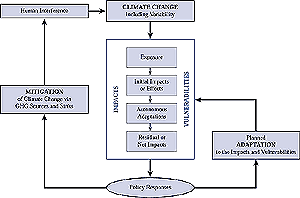|
1. Scope and Approach of the Assessment
1.1. Mandate of the Assessment
The Intergovernmental Panel on Climate Change (IPCC) was established by World
Meteorological Organization and United Nations Environmental Programme (UNEP)
in 1988 to assess scientific, technical, and socioeconomic information that
is relevant in understanding human-induced climate change, its potential impacts,
and options for mitigation and adaptation. The IPCC currently is organized into
three Working Groups: Working Group I (WGI) addresses observed and projected
changes in climate; Working Group II (WGII) addresses vulnerability, impacts,
and adaptation related to climate change; and Working Group III (WGIII) addresses
options for mitigation of climate change.
This volume—Climate Change 2001: Impacts, Adaptation, and Vulnerability—is
the WGII contribution to the IPCC's Third Assessment Report (TAR) on scientific,
technical, environmental, economic, and social issues associated with the climate
system and climate change.1 WGII's
mandate for the TAR is to assess the vulnerability of ecological systems, socioeconomic
sectors, and human health to climate change as well as potential impacts of
climate change, positive and negative, on these systems. This assessment also
examines the feasibility of adaptation to enhance the positive effects of climate
change and ameliorate negative effects. This new assessment builds on previous
IPCC assessments, reexamining key findings of earlier assessments and emphasizing
new information and implications from more recent studies.
1.2. What is Potentially at Stake?

Figure TS-1: Scope of the Working Group II assessment. |
Human activities—primarily burning of fossil fuels
and changes in land cover—are modifying the concentration of atmospheric
constituents or properties of the surface that absorb or scatter radiant energy.
The WGI contribution to the TAR—Climate Change 2001:
The Scientific Basis—found, "In the light of new evidence
and taking into account the remaining uncertainties, most of the observed warming
over the last 50 years is likely to have been due to the increase in greenhouse
gas concentrations." Future changes in climate are expected to include
additional warming, changes in precipitation patterns and amounts, sea-level
rise, and changes in the frequency and intensity of some extreme events.
The stakes associated with projected changes in climate are high. Numerous
Earth systems that sustain human societies are sensitive to climate and will
be impacted by changes in climate (very high confidence). Impacts can be expected
in ocean circulation; sea level; the water cycle; carbon and nutrient cycles;
air quality; the productivity and structure of natural ecosystems; the productivity
of agricultural, grazing, and timber lands; and the geographic distribution,
behavior, abundance, and survival of plant and animal species, including vectors
and hosts of human disease. Changes in these systems in response to climate
change, as well as direct effects of climate change on humans, would affect
human welfare, positively and negatively. Human welfare would be impacted through
changes in supplies of and demands for water, food, energy, and other tangible
goods that are derived from these systems; changes in opportunities for nonconsumptive
uses of the environment for recreation and tourism; changes in non-use values
of the environment such as cultural and preservation values; changes in incomes;
changes in loss of property and lives from extreme climate phenomena; and changes
in human health. Climate change impacts will affect the prospects for sustainable
development in different parts of the world and may further widen existing inequalities.
Impacts will vary in distribution across people, places, and times (very high
confidence), raising important questions about equity.
Although the stakes are demonstrably high, the risks associated with climate
change are less easily established. Risks are a function of the probability
and magnitude of different types of impacts. The WGII report assesses advances
in the state of knowledge regarding impacts of climate stimuli to which systems
may be exposed, the sensitivity of exposed systems to changes in climate stimuli,
their adaptive capacity to alleviate or cope with adverse impacts or enhance
beneficial ones, and their vulnerability to adverse impacts (see Box
1). Possible impacts include impacts that threaten substantial and irreversible
damage to or loss of some systems within the next century; modest impacts to
which systems may readily adapt; and impacts that would be beneficial for some
systems.
Figure TS-1 illustrates the scope of the WGII assessment
and its relation to other parts of the climate change system. Human activities
that change the climate expose natural and human systems to an altered set of
stresses or stimuli. Systems that are sensitive to these stimuli are affected
or impacted by the changes, which can trigger autonomous, or expected, adaptations.
These autonomous adaptations will reshape the residual or net impacts of climate
change. Policy responses in reaction to impacts already perceived or in anticipation
of potential future impacts can take the form of planned adaptations to lessen
adverse effects or enhance beneficial ones. Policy responses also can take the
form of actions to mitigate climate change through greenhouse gas (GHG) emission
reductions and enhancement of sinks. The WGII assessment focuses on the central
box of Figure TS-1—exposure, impacts, and vulnerabilities—and
the adaptation policy loop.
Box 1. Climate Change
Sensitivity, Adaptability, and Vulnerability
Sensitivity is the degree to which a system is affected, either
adversely or beneficially, by climate-related stimuli. Climate-related
stimuli encompass all the elements of climate change, including mean climate
characteristics, climate variability, and the frequency and magnitude
of extremes. The effect may be direct (e.g., a change in crop yield in
response to a change in the mean, range or variability of temperature)
or indirect (e.g., damages caused by an increase in the frequency of coastal
flooding due to sea-level rise).
Adaptive capacity is the ability of a system to adjust to climate
change, including climate variability and extremes, to moderate potential
damages, to take advantage of opportunities, or to cope with the
consequences.
Vulnerability is the degree to which a system is susceptible to,
or unable to cope with, adverse effects of climate change, including climate
variability and extremes. Vulnerability is a function of the character,
magnitude and rate of climate change and variation to which a system is
exposed, its sensitivity, and its adaptive capacity.
|
|